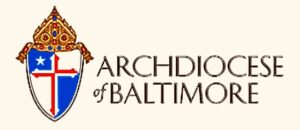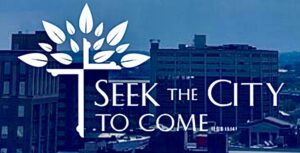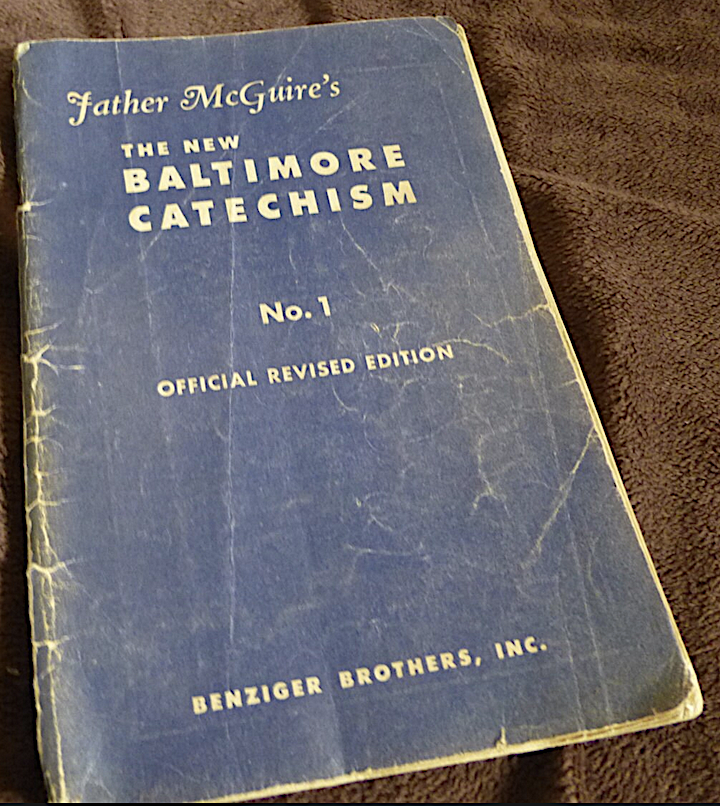How have the mighty fallen!
 When I was a kid being raised Catholic, the handbook for my “spiritual formation” (aka indoctrination) was arranged as a series of questions and answers. In early editions, there were as many as 1400 questions.
When I was a kid being raised Catholic, the handbook for my “spiritual formation” (aka indoctrination) was arranged as a series of questions and answers. In early editions, there were as many as 1400 questions.
I didn’t actually read much of it, but listened to and repeated more, and still remember several of the opening queries. Like these (any readers who recognize them, repeat in unison):
Q. Who made me?
A. God made me.Q. Why did God make you?
A. God made me to know him, to love him, and to serve him in this world, and to be happy with Him for ever in heaven.Q. What must we do to save our souls?
A. To save our souls. we must worship God by faith. hope. and charity: that is. we must believe in Him. hope in Him. and love Him with all our heart.Q. How shall we know the things which we are to believe?
A. We shall know the things which we are to believe from the Catholic Church, through which God speaks to us.
Well, God was pretty busy in those days, what with the Cold War on one hand, and delaying the next hot one on the other, plus there were the likes of teenage me, on the loose and in church, edging toward the door.
Then–even scarier — came the drift in American federal courts toward unleashing an apocalyptic, worse-(judging by the attention God’s spokesmen gave it)-than-World-War-Three plague on the country, namely by legalizing “artificial” birth control. So He spoke to us kids through this book of the church, in the hands of lay teachers, or priests and nuns, and IIRC my mother as well.
The Baltimore Catechism had been the national standard among U.S. Catholics for three generations by the time I heard and memorized its key refrains. That was when Dwight “Ike” Eisenhower was settling into the White House, and my parents bought our first television set.
 While many social changes were just beginning to stir, Baltimore and its Catechism then seemed secure as the unofficial capitol of American Catholicism. Its archdiocese (the nation’s first) had become a domestic empire: dozens of big churches were built, along with scores of parochial schools, not one but two seminaries, colleges, and even the very influential Woodstock Theological Center. Its recent archbishops were made cardinals, with the red caps marking them as “princes of the church.”
While many social changes were just beginning to stir, Baltimore and its Catechism then seemed secure as the unofficial capitol of American Catholicism. Its archdiocese (the nation’s first) had become a domestic empire: dozens of big churches were built, along with scores of parochial schools, not one but two seminaries, colleges, and even the very influential Woodstock Theological Center. Its recent archbishops were made cardinals, with the red caps marking them as “princes of the church.”
But . . .
. . . That was then.
Birth control was indeed legalized, by the early Seventies. The Baltimore Catechism was phased out starting in the 1990s (after just over a century, a heckuva good run). And I exited my teens and the church, then wound up a Quaker (not the worst outcome in my generation, but a permanent burden for my devout mother).
Then the rising flood of exposures and prosecutions about the long-hidden sexual abuse underworld beneath Roman cloaks and cassocks hit the archdiocese hard, again and again. Last year the state of Maryland issued a searching, scalding report. It was one of many such of the past two decades. Their cumulative effect has sent more than thirty U. S. Catholic dioceses and major institutions into bankruptcy. Last September the Baltimore archdiocese joined this humiliating company, filing for Chapter 11.
But the sex abuse avalanche of disgrace, litigation and bad publicity is not directly why Baltimore’s archdiocese was big in the local news this week.
Monday the Baltimore Sun led the ranks of media turning their spotlight on a new proposal by William Lori, Baltimore’s present archbishop. His plan portends a spiritual shock that offers an eerie counterpart to the impact of the Key Bridge collapse on the city’s economy.
The plan caught my attention because of the magnitude of Lori’s proposed downsizing, and the similarity of what’s happening there to declines in many other churches in the U.S. and Europe, including my Quakers.
Let’s go quickly over the Sun’s summary of archbishop Lori’s proposal, which is titled “Seek the City to Come.” It’s drawn from a verse in the New Testament Letter to the Hebrews: “For here we have no continuing city, but we seek one to come.” Hebrews 13:14. I found the plan stunning, as a stark summary of the drastic decline of this once-pre-eminent church stronghold.
Baltimore Sun — April 15, 2024
Local News
Baltimore Catholic cutbacks:
What to know about the archdiocese proposal
By Jonathan M. Pitts
[Excerpts; with Comments, and Emphasis Added.]
Here’s what to know about what the church calls “Seek the City to Come,” its initiative to grapple with shrinking congregations in many urban parishes, some of which also have aging buildings and large campuses.
What’s closing?
If approved, the plan would eliminate 61 existing parishes and establish 21 larger ones. Dozens of churches would merge with others, see their buildings repurposed or close. . . .
The Baltimore proposal features aspects of similar initiatives in Cleveland, Chicago, Cincinnati, Detroit and St. Louis.
Twenty-six of the 59 Catholic churches in Baltimore would continue functioning as multipurpose “worship sites.” . . .
5 landmark churches that would go away . . . .Why is this happening?
Attendance at city Catholic churches has cratered, leaving its infrastructure expensive, unwieldy and overly big and the conduct of its ministries inadequate to modern demands. On any given weekend, only about 2,000 of 25,000 seats in the pews are occupied.
[COMMENT: This is a revealing and shocking statistic. While attendance has been dropping in most American religious denominations, this is cataclysmic.
Not mentioned in the report are area Catholic schools. But since 2010, close to twenty Catholic schools in the archdiocese have been closed.]
Here’s a landmark snapshot: the historic St. Vincent de Paul Parish has closed the corner park adjacent to its downtown Baltimore church often used by the homeless. The park’s gates have been locked and yellow caution tape has been strung across the church steps. Signs have been posted saying the park has been closed due to vandalism, drug use and drug sales.
Catholics will have the chance to comment on the proposal, either online or at two town hall meetings this month. After it’s adjusted with their input, it goes to archdiocesan leaders for consideration.
Who makes the final call?
Archbishop William E. Lori will sign off on a final version in May or June.
[COMMENT: There have been extensive discussions. But in the end, the Catholic church is not a democracy; the hierarchy rules. Nothing new about that; top-down is a core Catholic tradition.
Yet neither archbishops nor the Vatican can fill the benches (or schools, seminaries and collection plates) by fiat. If Baltimore Catholics don’t get to cast ballots on this plan — they can and have been voting with their feet, for years: and the “polls” point to 23000 empty seats, and shriveled donor income, which bishops and pope Francis have to cope with as best they can.
This plan bespeaks monumental institutional breakdown and disintegration. And it is not the result of any outside conquest or persecution,
Something similar has been happening in Quakerism too, if less spectacularly. There has been abuse, but not as widespread. More generally, meetings and churches of all varieties in the U.S. have seen a quiet exodus, particularly of younger people, and the effects have been significant.
 In late 2023 the main Friends conference & study center in Britain, Woodbrooke in Birmingham, shut down, after 120 years. And membership in many American Yearly Meetings (the Quaker equivalent of a diocese, sans bishops) is shrinking. Cultural and doctrinal strife has damaged others. Many budgets are tightening even in a year when the general economy is reportedly doing well and unemployment is low.
In late 2023 the main Friends conference & study center in Britain, Woodbrooke in Birmingham, shut down, after 120 years. And membership in many American Yearly Meetings (the Quaker equivalent of a diocese, sans bishops) is shrinking. Cultural and doctrinal strife has damaged others. Many budgets are tightening even in a year when the general economy is reportedly doing well and unemployment is low.
The main Quaker body in Maryland is — Baltimore Yearly Meeting. Its member groups extend across Maryland, plus Virginia, D.C., and a scattering in central Pennsylvania. It’s much older than the archdiocese, just passed its 350th anniversary. It doesn’t hold its yearly sessions in Baltimore any more, but tradition has blocked moves to update the name. Its hierarchy is minimal, and overhead infrastructure costs are thus lower. So its denominational plight, though hardly untroubled, is not as dire as that of the archdiocese.

Still, these days even many Quakers are wondering if they have “a continuing city” to count on. And there’s no standard Quaker catechism to offer long-settled answers or remedies.
In Lori’s glossy but bottomlessly gloomy plan booklet, it looks like there’s no more reliable answers in the Catholic world either — beyond close up and sell half (or more) of everything, pay as many of the abuse claims as possible, and maybe pray for a miracle.
Catholics believe in miracles . . . it says so somewhere in the Catechism. (Some Quakers do too).
But miracles, as Archbishop Lori (or any Baltimorean who formerly commuted via the Key bridge) can tell you, have been in short supply of late.


It’s a fitting end, to be sure. I unbecame a Catholic when I left home for college, and only darkened the church door to attend Chistmas eve high mass with my father ( the Marietta church had a wonderful tenor).
My great great grandmother Ruth S Murray wrote a Quaker Catechism that was published by New England Yearly Meeting – Orthodox in the late 19th century…. it would just help us know Scriptural verses that support a solidly Christian view of Quakerism.